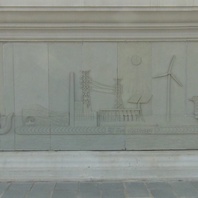
Item
Win-Win Monument bas-relief
This photograph provides a view of bas-relief on the 117-metre-long engraved base of the Win-Win Monument. This section celebrates the achievements of different ministries in Cambodia, in this detail the Ministry of Mines and Energy. The ministry is represented by carvings of electric poles, solar panels, wind turbines and offshore oil rigs. The Win-Win Monument complex – photographed here in January 2020 – was inaugurated in December 2018 to mark the twentieth anniversary of the end of the post-Democratic Kampuchea civil war, with the final defection of the remaining Khmer Rouge factions, thanks to the DIFID policy (“Divide, Isolate, Finish, Integrate, Develop”) also known as the “Win Win” policy of Prime Minister Hun Sen.
Read More
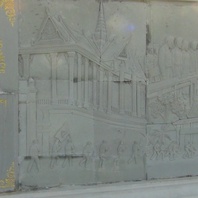
Item
Win-Win Monument bas-relief
The photograph shows a view of bas-relief on the 117-metre-long engraved base of the Win-Win Monument. It depicts the takeover of Phnom Penh in January 1979 by troops from the Kampuchea United Front for National Salvation (FUNSK) and Vietnamese forces. One sees soldiers with a flag of Cambodia passing the Royal Palace. The Win-Win Monument complex – photographed here in January 2020 – was inaugurated in December 2018 to mark the twentieth anniversary of the end of the post-Democratic Kampuchea civil war, with the final defection of the remaining Khmer Rouge factions, thanks to the DIFID policy (“Divide, Isolate, Finish, Integrate, Develop”) also known as the “Win Win” policy of Prime Minister Hun Sen.
Read More
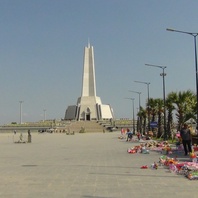
Item
General view of Win-Win Monument Plaza
The Win-Win Monument obelisk (33 metres in height) – photographed here in January 2020 – is part of the monumental complex inaugurated in December 2018 to mark the twentieth anniversary of the end of the post-Democratic Kampuchea civil war, with the final defection of the remaining Khmer Rouge factions, thanks to the DIFID Policy (“Divide, Isolate, Finish, Integrate, Develop”) also known as the “Win Win” policy of Prime Minister Hun Sen.
Read More
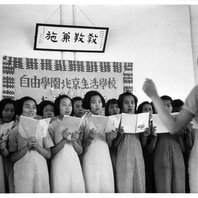
Item
A chorus group [sic]
From a collection of staged photographs produced under the title “Life at a Girls School in Peking”, and produced at the Peking Jiyu Gakuen in Japanese-occupied Beijing.
Read More
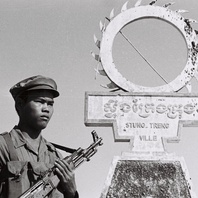
Featured Item
Armed soldier of the Kampuchea United Front for National Salvation
This unattributed image of armed soldier of the Kampuchea United Front for National Salvation (KUFNS, also known as FUNSK) [Front or Renakse] at the entrance of Stung Treng Municipality (northeastern Cambodia) is taken from a low angle. It shows the head and upper torso of the soldier. The man firmly holds his rifle and looks extremely focused. The other half of the picture shows the sculpture-symbol at the entrance of Stung Treng, a dented circle on a pedestal. This image was featured in the publication (French and English versions) entitled The People’s Republic of Kampuchea (1979). This photograph is part of the collection held by the Agence Khmère de Presse (AKP) and Cambodia’s Ministry of Information. This collection, which documents the early years of the People’s Republic of Kampuchea as photographed by the Vietnamese and a small team of Cambodian photographers, has not yet been classified or indexed.
Read More
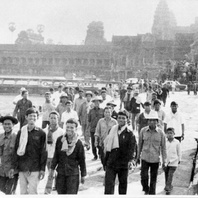
Featured Item
Crowds visiting Angkor Wat
This unattributed photograph shows a group of Cambodians on their way back from visiting Angkor Wat. The temple is visible in the background. The visitors are mostly men, with a few children and teenagers, with the people at the front smiling at the photographer. This photograph is part of the collection held by the Agence Khmère de Presse (AKP) and Cambodia’s Ministry of Information. This collection, which documents the early years of the People’s Republic of Kampuchea as photographed by the Vietnamese and a small team of Cambodian photographers, has not yet been classified or indexed.
Read More
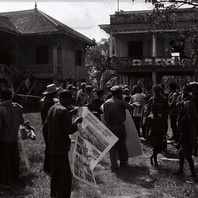
Featured Item
Posters being distributed to villagers
This photograph shows soldiers distributing illustrated posters celebrating the Kampuchea United Front for National Salvation (KUFNS, also known as FUNSK) [Front or Renakse] to a group of villagers. It is part of a series that describes the same group of villagers and soldiers. This photograph is part of the collection held by the Agence Khmère de Presse (AKP) and Cambodia’s Ministry of Information. This collection, which documents the early years of the People’s Republic of Kampuchea as photographed by the Vietnamese and a small team of Cambodian photographers, has not yet been classified or indexed.
Read More
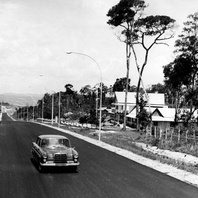
Featured Item
Newly laid road in Sihanoukville
This unattributed photograph shows a car travelling on a newly laid asphalt road connecting Sihanoukville and Phnom Penh in the mid 1960s. The photograph is part of the collection that was donated to the National Archives of Cambodia from the Library of the Royal University of Fine Arts by Darryl Collins and Helen Grant Ross in 2003. The collection was used by Collins and Ross for their research into urbanisation. The images were probably originally used to mount the Sangkum Reastr Niyum Permanent Exhibition at the Exhibition Hall, Bassac area, Phnom Penh.
Read More
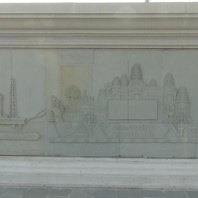
Item
Win-Win Monument bas-relief
This photograph provides a view of bas-relief on the 117-metre-long engraved base of the Win-Win Monument. This section celebrates the achievements of different ministries, in this detail the Ministry of Tourism. The ministry is represented by a carving of Angkor Wat on a Naga (a mythological part-human part-cobra creature). The Win-Win Monument complex – photographed here in January 2020 – was inaugurated in December 2018 to mark the twentieth anniversary of the end of the post-Democratic Kampuchea civil war, with the final defection of the remaining Khmer Rouge factions, thanks to the DIFID policy (“Divide, Isolate, Finish, Integrate, Develop”) also known as the “Win Win” policy of Prime Minister Hun Sen.
Read More
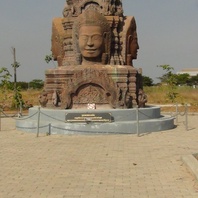
Item
Miniature monuments at the Win-Win Monument complex
This photograph shows a miniature reproduction of a four-faced Buddha statue at the Temple Bayon (Angkor Wat). A garden located on the northern side of the Win-Win Monument complex displays several miniature reproductions of iconic Khmer monuments. The Win-Win Monument complex – photographed here in January 2020 – was inaugurated in December 2018 to mark the twentieth anniversary of the end of the post-Democratic Kampuchea civil war, with the final defection of the remaining Khmer Rouge factions, thanks to the DIFID policy (“Divide, Isolate, Finish, Integrate, Develop”) also known as the “Win Win” policy of Prime Minister Hun Sen.
Read More
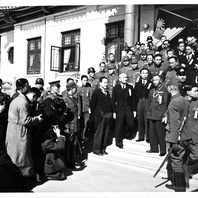
Item
RNG leaders on steps of Government Headquarters, November 1940
Flanked by civilian and military staff, Wang Jingwei, Zang Shiyi (the Manchukuo ambassador to the RNG) and Chu Minyi (RNG foreign minister) pose for photographs in front of the ceremonial hall (litang) in the national government compound in Nanjing after the signing of the Japan-Manchukuo-China Joint Declaration on 30 November 1940, through which RNG China recognised Manchukuo.
Read More
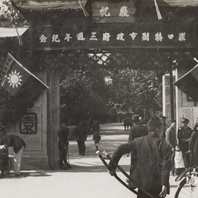
Item
Park in Wuhan, spring 1943
Photograph of a park in Wuhan festooned to “Celebrate the 3rd anniversary of the founding of the Hankou Municipal Government” (Qingzhu Hankou tebie shi zhengfu san zhounian jinian). While Wuhan is often remembered as a centre of anti-Japanese resistance in the early war years, it was also incorporated into the RNG realm in 1940, and became a major political and cultural centre for that administration. Interestingly, the ROC flag shown here still includes the RNG pennant (which read “peace, anti-communism, and nation building”, and which had been added to the flag in 1940), even though Chinese authorities in occupied areas were, from January 1943 onwards, not obliged to include this pennant.